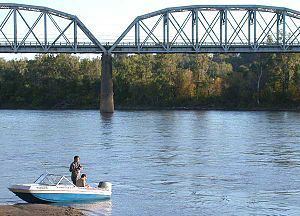Carries Railroad Construction begin May 1916 Body of water Missouri River Owner Union Pacific Railroad | Crosses Missouri River Opened 20 December 1916 Location Council Bluffs | |
 | ||
Locale Council Bluffs, Iowa to Omaha, Nebraska Similar Illinois Central Missouri, South Omaha Veterans, Burlington Headquarters Building, Ak‑Sar‑Ben Bridge, Florence Depot | ||
The Union Pacific Missouri River Bridge is a rail truss bridge across the Missouri River connecting Council Bluffs, Iowa with Omaha, Nebraska.
History
When the first railroad bridge on the site opened on March 27, 1872, it connected the First Transcontinental Railroad to the eastern United States. The bridge was rebuilt twice, with the current bridge opening on December 20, 1916.
When the Union Pacific began heading west from Omaha in 1862 there were no railroads connecting to it from the east. After the Chicago and North Western Railway reached Council Bluffs in 1867, the Union Pacific for a while tried to run freight trains across the frozen river during the winter. The Union Pacific Transfer company maintained a ferry service from 1866 to 1872.
In 1869 the transcontinental railroad was completed. An 1871 report to stockholders has this description:
The want of a bridge over the Missouri River, at Omaha to connect the eastern railroads with the Union Pacific, has been one of the most annoying incidents connected with the trip to California ... The bridge is of 11 spans, 250 feet each, 50 feet above high water, resting upon one store abutment now complete; and 11 iron piers, all in place and the larger part already sunk from 60 to 72 feet in the sand, and resting in the bed-rock.
The new single-track railway bridge was completed in 1872 at a cost of 1,750,000 dollars ($35 million in present day terms). It was the first bridge to span the Missouri River at any point. In 1877, a tornado weakened the two easternmost spans, requiring them to be replaced with a wooden trestle.
In 1885, to keep pace with the growing demand for railway transportation, construction began on a new bridge. Designed and built under the direction of George S. Morison, it opened in the fall of 1887. It was 1,750 feet long, with four Whipple trusses on stone masonry piers and three deck spans at each end. It was the first double-track railway bridge across the Missouri River.
The 1888 bridge also became obsolete. The peak year for American railroad track mileage was 1916. Nearly all interstate commerce went by rail. Six trunk lines of railroad used this bridge, with an average 320 freight and passenger trains crossing every 24 hours. Union Pacific decided to upgrade the Missouri River crossing to handle the traffic and tonnage, and work began in May 1916. To keep this critical artery open, the replacement bridge was constructed on temporary wooden piles immediately upstream of the 1888 stone piers. Another set of piles was driven into the river bed on the downstream side of the piers. When the new bridge was completed the old bridge was rigged with cables and winched from the stone piers to the temporary wood piles. The cables were rerigged to the new structure and it was pulled onto the stone piers. Tracks were connected and traffic resumed with just one hour of interruption. The 1888 bridge was then dismantled.
The approaches to the bridge were a mile and a half on each side. The Union Pacific initially committed to including a roadway with the bridge. However, it recanted, and it would not be until 1888 when the Douglas Street Bridge, later called the Ak-Sar-Ben Bridge, was opened as a roadway connecting the cities.
